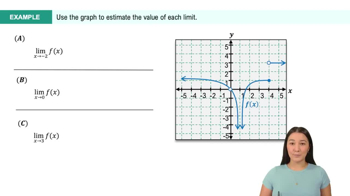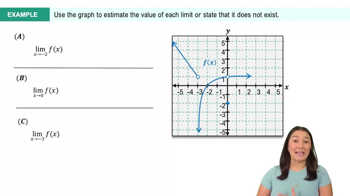Table of contents
- 0. Functions7h 52m
- Introduction to Functions16m
- Piecewise Functions10m
- Properties of Functions9m
- Common Functions1h 8m
- Transformations5m
- Combining Functions27m
- Exponent rules32m
- Exponential Functions28m
- Logarithmic Functions24m
- Properties of Logarithms34m
- Exponential & Logarithmic Equations35m
- Introduction to Trigonometric Functions38m
- Graphs of Trigonometric Functions44m
- Trigonometric Identities47m
- Inverse Trigonometric Functions48m
- 1. Limits and Continuity2h 2m
- 2. Intro to Derivatives1h 33m
- 3. Techniques of Differentiation3h 18m
- 4. Applications of Derivatives2h 38m
- 5. Graphical Applications of Derivatives6h 2m
- 6. Derivatives of Inverse, Exponential, & Logarithmic Functions2h 37m
- 7. Antiderivatives & Indefinite Integrals1h 26m
- 8. Definite Integrals3h 25m
1. Limits and Continuity
Introduction to Limits
Problem 2.7.1
Textbook Question
Suppose x lies in the interval (1, 3) with x≠2. Find the smallest positive value of δ such that the inequality 0<|x−2|<δ is true.
 Verified step by step guidance
Verified step by step guidance1
Identify the point of interest, which is x = 2, and note that we want to find δ such that x is within the interval (1, 3) but not equal to 2.
Rewrite the inequality |x - 2| < δ to express it in terms of x: this means we want the distance between x and 2 to be less than δ.
Determine the bounds for x based on the interval (1, 3) while ensuring x ≠ 2. This means we need to consider the distances from 2 to the endpoints of the interval.
Calculate the distances from 2 to the nearest endpoints of the interval: the distance from 2 to 1 is |2 - 1| = 1, and the distance from 2 to 3 is |2 - 3| = 1.
Since δ must be less than both distances, the smallest positive value of δ that satisfies the inequality is the minimum of these distances, which is 1.
Was this helpful?

 6:47m
6:47mWatch next
Master Finding Limits Numerically and Graphically with a bite sized video explanation from Callie
Start learning





